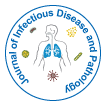开放获取期刊获得更多读者和引用
700 种期刊 和 15,000,000 名读者 每份期刊 获得 25,000 多名读者
抽象的
Expression and Characterization of Capsid Proteins Derived from GII.17 and GII.7 Noroviruses
Xin Wan, Wenhui Wang, Yuqi Huo,Tong Ling, Li Ding, Jie Wu, Shengli Meng, Zejun Wang* and Shuo Shen*
Objective: Noroviruses (NoVs) are the leading cause of non-bacterial gastroenteritis worldwide and genogroup II, genotype 4 variants have been responsible for the majority of outbreaks reported. In winter 2014-15, the transient burst outbreaks caused by a new GII.17 variant that differed from previous strains was observed in several countries. In this study, major capsid proteins derived from GII.17 and GII.7 NoVs were expressed in sf9 cells and used to produce hyperimmune sera in rabbits for characterization of GII.17 and GII7 NoV Virus like particles (VLPs).
Methods: Baculovirus-insect cell expression system was used to assemble NoV VLPs. Salivary HBGA-viruslike particle (VLP) binding and binding blockade assays were performed.
Results: High expression levels were observed for both capsid proteins and expression led to successful assembly of VLPs. CsCl density gradient centrifugation indicated presence of two bands for both VLPs and SDS-PAGE analysis of these two bands showed contradictory ratio of the full-length and truncated capsid proteins. Both VLPs bound to salivary HBGAs derived from blood type A, B, AB and O individuals. In vitro HBGA-VLP binding blockade assay using hyperimmune sera against multiple genotypes, including current pandemic Sydney 2012 GII.4, GI.2, GII.7 and GII.17 VLPs demonstrated absence of blocking antibodies against the binding of GII.17 and GII.7 VLPs to salivary HBGAs.
Conclusion: The expression of GII.17 and GII.7 capsid proteins and VLP assembling allowed the antigenic comparison of different recombinant NoVs.

 English
English  Spanish
Spanish  Russian
Russian  German
German  French
French  Japanese
Japanese  Portuguese
Portuguese  Hindi
Hindi